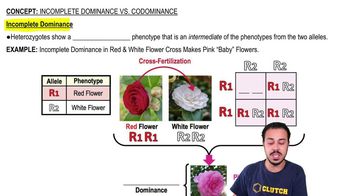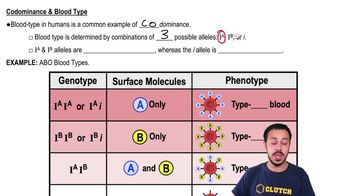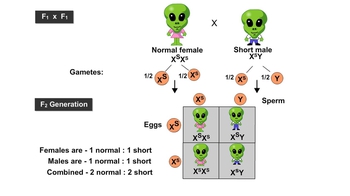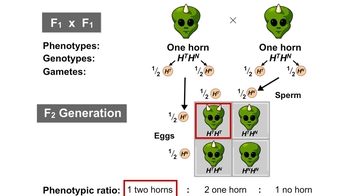Table of contents
- 1. Introduction to Biology2h 40m
- 2. Chemistry3h 40m
- 3. Water1h 26m
- 4. Biomolecules2h 23m
- 5. Cell Components2h 26m
- 6. The Membrane2h 31m
- 7. Energy and Metabolism2h 0m
- 8. Respiration2h 40m
- 9. Photosynthesis2h 49m
- 10. Cell Signaling59m
- 11. Cell Division2h 47m
- 12. Meiosis2h 0m
- 13. Mendelian Genetics4h 41m
- Introduction to Mendel's Experiments7m
- Genotype vs. Phenotype17m
- Punnett Squares13m
- Mendel's Experiments26m
- Mendel's Laws18m
- Monohybrid Crosses16m
- Test Crosses14m
- Dihybrid Crosses20m
- Punnett Square Probability26m
- Incomplete Dominance vs. Codominance20m
- Epistasis7m
- Non-Mendelian Genetics12m
- Pedigrees6m
- Autosomal Inheritance21m
- Sex-Linked Inheritance43m
- X-Inactivation9m
- 14. DNA Synthesis2h 27m
- 15. Gene Expression3h 20m
- 16. Regulation of Expression3h 31m
- Introduction to Regulation of Gene Expression13m
- Prokaryotic Gene Regulation via Operons27m
- The Lac Operon21m
- Glucose's Impact on Lac Operon25m
- The Trp Operon20m
- Review of the Lac Operon & Trp Operon11m
- Introduction to Eukaryotic Gene Regulation9m
- Eukaryotic Chromatin Modifications16m
- Eukaryotic Transcriptional Control22m
- Eukaryotic Post-Transcriptional Regulation28m
- Eukaryotic Post-Translational Regulation13m
- 17. Viruses37m
- 18. Biotechnology2h 58m
- 19. Genomics17m
- 20. Development1h 5m
- 21. Evolution3h 1m
- 22. Evolution of Populations3h 52m
- 23. Speciation1h 37m
- 24. History of Life on Earth2h 6m
- 25. Phylogeny2h 31m
- 26. Prokaryotes4h 59m
- 27. Protists1h 12m
- 28. Plants1h 22m
- 29. Fungi36m
- 30. Overview of Animals34m
- 31. Invertebrates1h 2m
- 32. Vertebrates50m
- 33. Plant Anatomy1h 3m
- 34. Vascular Plant Transport2m
- 35. Soil37m
- 36. Plant Reproduction47m
- 37. Plant Sensation and Response1h 9m
- 38. Animal Form and Function1h 19m
- 39. Digestive System10m
- 40. Circulatory System1h 57m
- 41. Immune System1h 12m
- 42. Osmoregulation and Excretion50m
- 43. Endocrine System4m
- 44. Animal Reproduction2m
- 45. Nervous System55m
- 46. Sensory Systems46m
- 47. Muscle Systems23m
- 48. Ecology3h 11m
- Introduction to Ecology20m
- Biogeography14m
- Earth's Climate Patterns50m
- Introduction to Terrestrial Biomes10m
- Terrestrial Biomes: Near Equator13m
- Terrestrial Biomes: Temperate Regions10m
- Terrestrial Biomes: Northern Regions15m
- Introduction to Aquatic Biomes27m
- Freshwater Aquatic Biomes14m
- Marine Aquatic Biomes13m
- 49. Animal Behavior28m
- 50. Population Ecology3h 41m
- Introduction to Population Ecology28m
- Population Sampling Methods23m
- Life History12m
- Population Demography17m
- Factors Limiting Population Growth14m
- Introduction to Population Growth Models22m
- Linear Population Growth6m
- Exponential Population Growth29m
- Logistic Population Growth32m
- r/K Selection10m
- The Human Population22m
- 51. Community Ecology2h 46m
- Introduction to Community Ecology2m
- Introduction to Community Interactions9m
- Community Interactions: Competition (-/-)38m
- Community Interactions: Exploitation (+/-)23m
- Community Interactions: Mutualism (+/+) & Commensalism (+/0)9m
- Community Structure35m
- Community Dynamics26m
- Geographic Impact on Communities21m
- 52. Ecosystems2h 36m
- 53. Conservation Biology24m
13. Mendelian Genetics
Incomplete Dominance vs. Codominance
Problem 2
Textbook Question
Textbook QuestionA man with type A blood marries a woman with type B blood. Their child has type O blood. What are the genotypes of these three individuals? What genotypes, and in what frequencies, would you expect in future offspring from this marriage?
 Verified step by step guidance
Verified step by step guidance1
Step 1: Identify the blood types and their corresponding genotypes. Type A blood can be AA or AO, type B blood can be BB or BO, and type O blood is always OO.
Step 2: Determine the parents' genotypes based on the child's blood type. Since the child has type O blood (OO), each parent must have contributed an O allele. Therefore, the man's genotype must be AO and the woman's genotype must be BO.
Step 3: Use a Punnett square to predict the genotypes of future offspring. The Punnett square for this cross would look like this:
| | A | O |
|---|---|---|
| B | AB | BO |
| O | AO | OO |
Step 4: Determine the frequencies of the genotypes. According to the Punnett square, there is a 25% chance for each genotype (AB, BO, AO, OO) in future offspring.
Step 5: Translate the genotypes into blood types. The possible blood types for future offspring are A (AO), B (BO), AB (AB), and O (OO), each with a 25% chance.
Recommended similar problem, with video answer:
 Verified Solution
Verified SolutionThis video solution was recommended by our tutors as helpful for the problem above
Video duration:
1mPlay a video:
Was this helpful?
Key Concepts
Here are the essential concepts you must grasp in order to answer the question correctly.
Blood Type Genetics
Blood types are determined by the ABO gene, which has three alleles: A, B, and O. A and B are co-dominant, meaning that if both are present, both traits are expressed, while O is recessive. Therefore, individuals with type A blood can have genotypes AA or AO, and those with type B can have BB or BO. Type O blood results from the genotype OO.
Recommended video:
Guided course
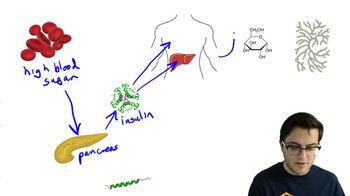
Blood Sugar Homeostasis
Punnett Square
A Punnett square is a tool used in genetics to predict the genotypes of offspring from parental genotypes. By arranging the alleles of each parent along the axes of a grid, one can visualize the possible combinations of alleles in the offspring. This method helps in determining the probabilities of each genotype occurring in future generations.
Recommended video:
Guided course

Punnett Squares
Mendelian Inheritance
Mendelian inheritance refers to the patterns of inheritance first described by Gregor Mendel, which include the principles of segregation and independent assortment. These principles explain how alleles segregate during gamete formation and how traits are inherited independently of one another. Understanding these principles is crucial for predicting the genetic outcomes of offspring in a given cross.
Recommended video:
Guided course

Polygenic Inheritance

 3:09m
3:09mWatch next
Master Incomplete Dominance with a bite sized video explanation from Jason Amores Sumpter
Start learningRelated Videos
Related Practice

